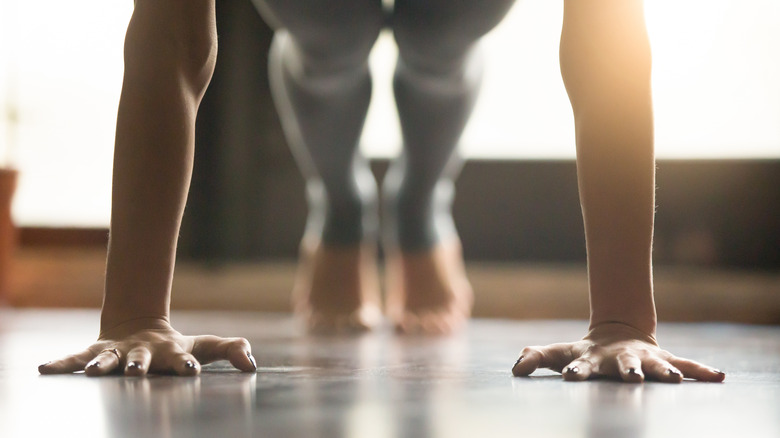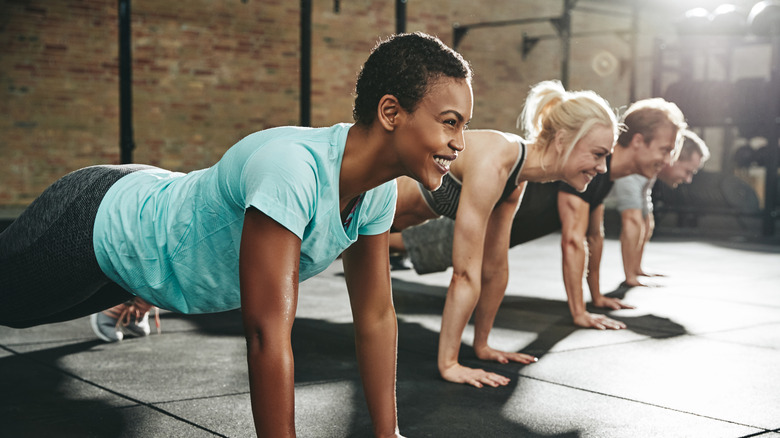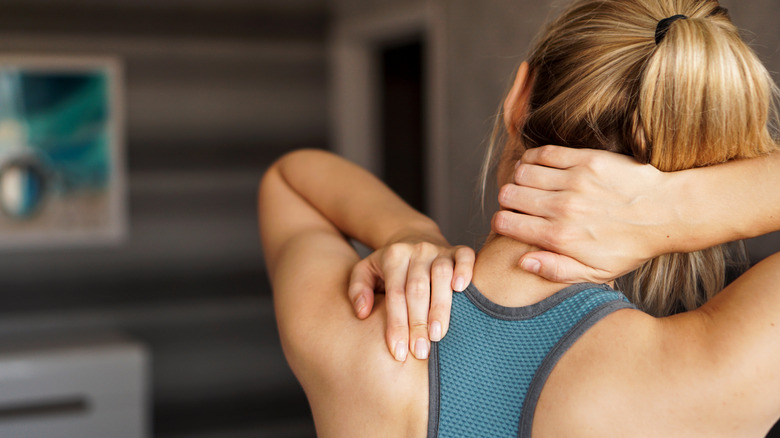This Is Why Pushups Are Hurting Your Neck
Pushups are an excellent exercise that works nearly your whole body. It's a compound bodyweight exercise that works your chest, arms, abs, back, and shoulders. You can even get your legs in on the workout with a modified pushup like the one-leg pushup or by using a resistance band. The difficulty in doing pushups comes from doing the exercise with proper form. It can seem like a relatively straightforward exercise until you get down on the floor and try to do 10 of them. It quickly gets hard to push your bodyweight off the floor, but the benefits are plenty (via Health).
Pushups are an effective exercise you can do just about anywhere, and you don't need any equipment. If you can't do a standard pushup yet, that's okay. Start with a wall pushup and then an incline pushup. With practice, you'll be able to do a standard pushup. The great thing about pushups is that when even a standard pushup becomes easy for you, you can use many variations to keep it difficult enough to keep working your muscles (via Livestrong).
Pushups can help your heart health. A 2019 study published in the JAMA Network discovered that men who could do 40 pushups in 30 seconds had a much lower risk of heart problems like heart failure and heart attacks than men who could only do less than 10 pushups. So do pushups for a healthy heart and strong muscles. But what if your neck hurts? What does that mean?
Muscle injury
If doing pushups causes neck pain, you are likely doing them wrong. Poor form during any exercise increases your risk of injury, and pushups are no different. When doing pushups, you may have strained or pulled a muscle in your neck. Signs you have a strained muscle are limited motion, swelling, and pain. If you think you have a strained muscle, you should use the RICE method — rest, apply ice, use compression, and elevate. If your strain is severe, you may need surgery. See your doctor if the pain is severe or doesn't go away (via Mayo Clinic).
A 2016 thesis from Western Washington University found that pushups work your trapezius muscles. This diamond-shaped muscle runs from your neck to your upper shoulders to the middle of your back. These muscles contract when doing pushups, moving your shoulder blades throughout the exercise. You can injure these muscles if you do too many pushups or don't have proper form during the exercise. The pain could also be caused by a pinched nerve or tendon.
Harvard Health Publishing points out that poor posture, specifically the position of your chin, can cause neck pain. As a result, you might feel an aching pain or even get a headache. Avoid neck pain with proper pushup form.
Pushup form
According to Sydney Morning Herald, craning your neck during pushups will cause neck pain. If your nose gets to the floor before your chest does, you're craning your neck. It's all about the position of your chin. Bring your chin in so your chest is the first thing to reach the floor. Check your posture by setting up your phone and recording yourself doing some pushups. Your body should be in a straight line from your head to your heels.
Start in a plank position with your toes and hands on the floor. Place your hands below your shoulders and move them out a bit. Feet are hip-width apart. Make sure you have that straight line in your body. Avoid curving your lower back by engaging your core. Imagine pulling your belly button in toward your back and contracting your abs. Make sure your head is in line with your shoulders. This is your starting position, and the only thing that changes is how far away your body is from the floor. When you allow your body to lower and push back up to do a pushup, your body should remain in this position. Bend your elbows and pivot at your toes to move up and down. Set your gaze between your hands to avoid craning your neck, and ensure your nose, chest, and belly button are in line (via the National Academy of Sports Medicine).
Relieve neck pain
If you're experiencing neck pain from craning your neck during pushups, you'll want some relief. Stretching can help. Harvard Health Publishing recommends trying this neck stretch to get some pain relief. Face forward while sitting or standing. Let your head bend to the side, bringing your ear to your shoulder. Hold for a few seconds, and do the same thing on the other side. Repeat 10 times. Get an extra stretch by rolling your head forward a little bit after you hold. Don't do this stretch if your pain gets worse during it.
Rest for a few days to allow your muscles time to heal. You can do some gentle stretching but avoid more challenging movements that affect your neck, shoulders, and upper back. Apply ice to reduce pain and swelling or heat to improve blood flow. Apply ice or heat for about 20 minutes, and take a break for at least two hours. Take an over-the-counter pain reliever like acetaminophen or nonsteroidal anti-inflammatory drugs (NSAIDs). Other treatments that can help relieve neck pain are massage therapy, mindfulness, meditation, acupuncture, and manual manipulation (via Spine-Health).
Of course, the best treatment is prevention, so make sure your pushup form is correct and avoid craning your neck. Practice your pushups slowly and steadily for the best results. Record yourself doing pushups to see where you need to improve. Don't force the pushups if you can't do them: Try wall pushups or incline pushups first.




